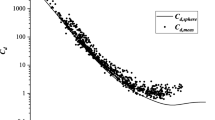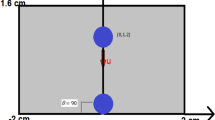Abstract
The terminal settling velocity (TSV) calculation of drops and other spherical objects in fluid medium is a classical problem, which has important application values in many fields such as the study of cloud and precipitation processes, the evaluation of soil erosion, and the determination of fluid viscosity coefficient etc. In this paper, a new explicit approximation model of TSV is established, which combines the theoretical solution of N-S equation about fluid motion around spherical objects and the statistical regression of solution dimensionless coefficients with measurement data. This new model can adapt to different values of drop parameters and medium parameters in a large range of Re. By this model, the relative and absolute calculation errors of TSV are in range of −3.42%−+ 4.34% and −0.271 m/s−+ 0.128 m/s respectively for drop radius 0.005−2.9 mm. Their corresponding root mean square values are 1.77% and 0.084 m/s respectively, which are much smaller than that of past theoretical and empirical models.
Similar content being viewed by others
References
Andsager K, Beard K V, Laird N F (1999). Laboratory measurements of axis ratio for large raindrops. J Atmos Sci, 56(15): 2673–2683
Beard K V, Pruppacher H R (1969). A determination of the terminal velocity and drag of small water drops by means of a wind tunnel. J Atmos Sci, 26(5): 1066–1072
Cao C M, Zhen Z (2013). Theoretical analysis of measuring viscosity coefficient by falling spere method in the experiment. Physics and Engineering, 23(2): 39–41 (in Chinese)
Ceylan K, Altunbas A, Kelbaliyev G (2001). A new model for estimation of drag force in the flow of Newtonian fluids around rigid or deformable particles. Powder Technol, 119(2–3): 250–256
Chen J Y (1975). The motion of bubbles, droplets, and solid spheres in a viscous fluid. China Sci, (4): 376–397
Cheng Y M (2018). Research on liquid viscosity coefficient measured by drop spere method. Science and Technology Innovation Herald, (25):107–109 (in Chinese)
Chester W, Breach D R (1969). On the flow past a sphere at low Reynolds number. J Fluid Mech, 37(4): 751–760
Gunn R, Kinzer G D (1949). The terminal velocity of fall for water droplets in stagnant air. J Atmos Sci, 6(4): 243–248
Guo H J, Sun S Y, Wang W (2018). Numerical simulation of single raindrop landing speed change. Journal of Water Resources & Water Engineering, 29(2): 257–260
Karamanev D G (1996). Equations for calculation of the terminal velocity and drag coefficient of solid spheres and gas bubbles. Chem Eng Commun, 147(1): 75–84
Laws J O (1941). Measurement of fall-velocity of water-drops and rain drops. Trans Am Geophys Union, 22(3): 709
Lv H X, Wu C L, Xiong Y Z, Li Y N (1997). Numerical simulation on rain drops falling velocity, Journal of Soil Erosion and Soil and Water Conservation, 3(2):14–21 (in Chinese)
Mason B J (1978). Cloud Physics. Beijing: Science Press
Oseen C W (1910). About Stoke’s formula and about a related problem in hydrodynamik. Ark F Math Astron Och Fys, 6(29): 1–20
Pruppacher H R, Steinberger E H (1968). Experimental determination of the drag on a sphere at low Reynolds numbers, J Appl Phys, 39(9):4129
Riazi A, Vila-Concejo A, Salles T, Türker U (2020). Improved drag coefficient and settling velocity for carbonate sands. Sci Rep, 10(1): 9465
Sheng P X, Mao J T, Li J G, Zhang A C, Sang J G, Pan N X (2003). Atmospheric Physics. Beijing: Peking University Press, 332–333
Stokes G G (1851). On the effect of internal friction on the motion of pendulums. Trans Cambridge Phil Soc, 9: 8–106
Sun X J, Sun H Y, Jiang Z D (2011). Numerical simulation of terminal velocity of raindrops falling under different atmospheric conditions. Computer Simulation, 28(12): 402–406
Sun J X, Wu G N, Gao G Q, Yang K S, Xu Y, Hu X Y (2014). Influence of dropping water droplets on electric field above train roof and countermeasures. High Voltage Engineering, 40(6): 1748–1755 (in Chinese)
Wu G N, Shao C M, Peng S, Yang K S, Zhang X Q (2017). Distribution of surface electric field of water and water droplets landing and its influence on the insulator flashover characteristics. High Voltage Engineering, 43(2): 557–566 (in Chinese)
Wang H T, Xu C Y, Dang L (2017). Theoretical computation for experiment of viscosity Coefficient of liquid under different temperature. Experiment Science and Technology, 15(5): 20–23 (in Chinese)
Yin Q, Xu S Z (1991). A calculation formula of the terminal velocity of water drops in the atmosphere. J Appl Meteorol, 2(2): 191–199
Author information
Authors and Affiliations
Corresponding author
Additional information
Author Biographies
Qiu YIN is a Research Professor of Shanghai Meteorological Service, China Meteorological Administration (CMA). He received his BS and MS degrees in atmospheric physics from Nanjing University and Ph.D Degree in physical electronics from Shanghai Institute of Technical Physics, Chinese Academy of Sciences (CAS). His research interests include atmospheric radiation model, spectral remote sensing information processing and application. He has published 2 national remote sensing standards and more than 100 academic papers.
Ci SONG is a Lecturer of College of Science, Zhongyuan University of Technology and post-doctor of School of Communication and Information Engineering, Shanghai University. She received her BS Degree in mathematics and applied mathematics from Henan Normal University in 2008, MS Degree in mathematics and applied mathematics from East China Normal University and Ph.D in physical geography from East China Normal University. Her research interests include remote sensing information processing and application, remote sensing mechanism and radiation transmission.
Rights and permissions
About this article
Cite this article
Yin, Q., Song, C. A high precision model for the terminal settling velocity of drops in fluid medium. Front. Earth Sci. 15, 947–955 (2021). https://doi.org/10.1007/s11707-020-0835-z
Received:
Accepted:
Published:
Issue Date:
DOI: https://doi.org/10.1007/s11707-020-0835-z




